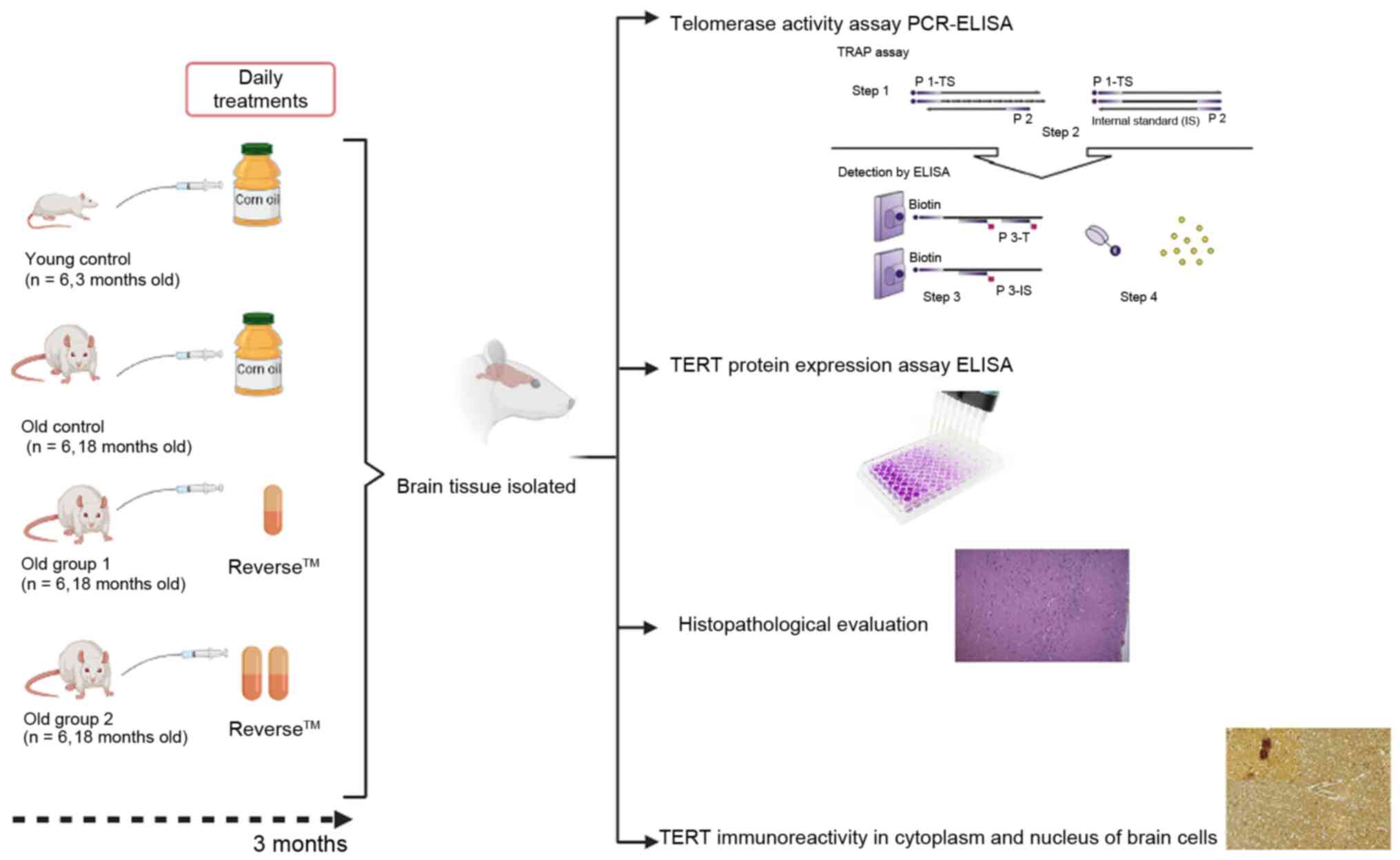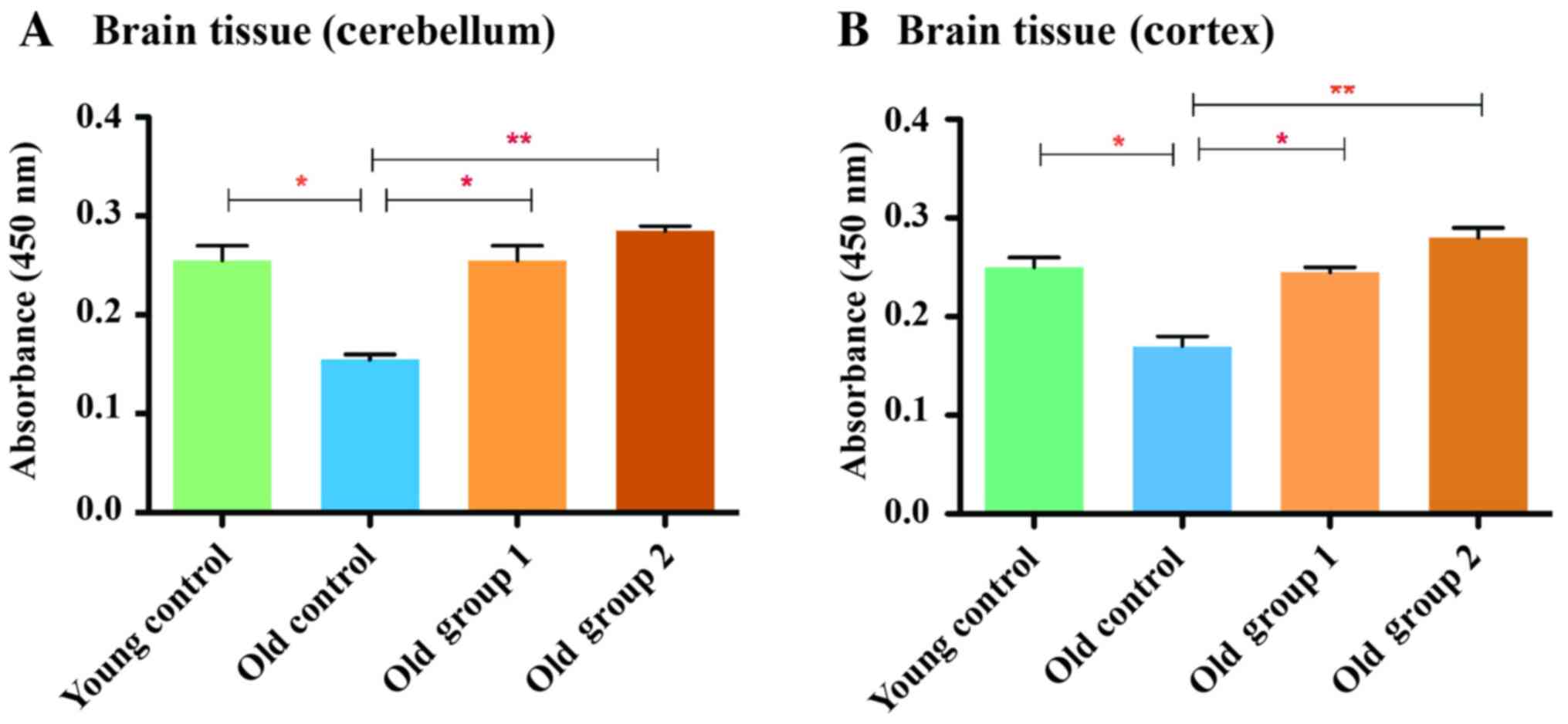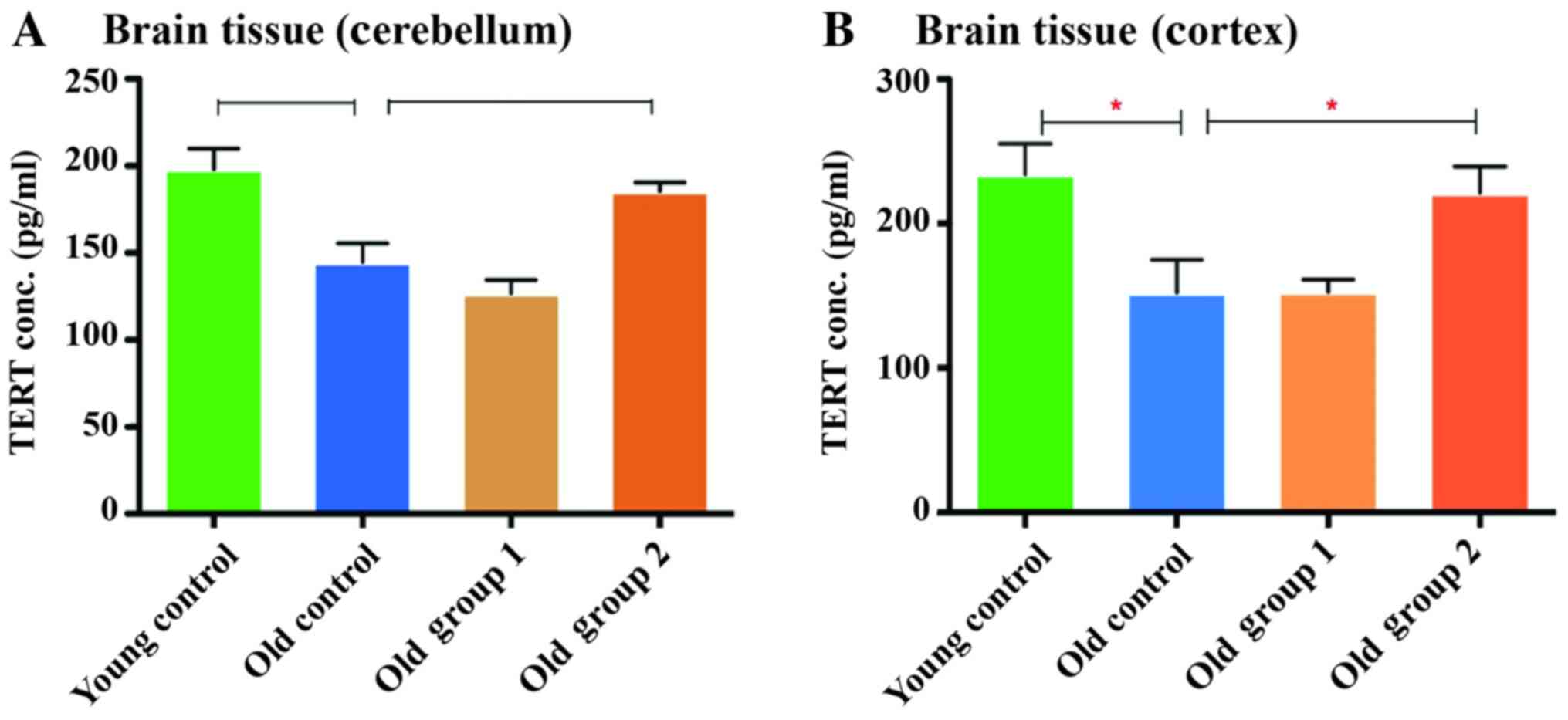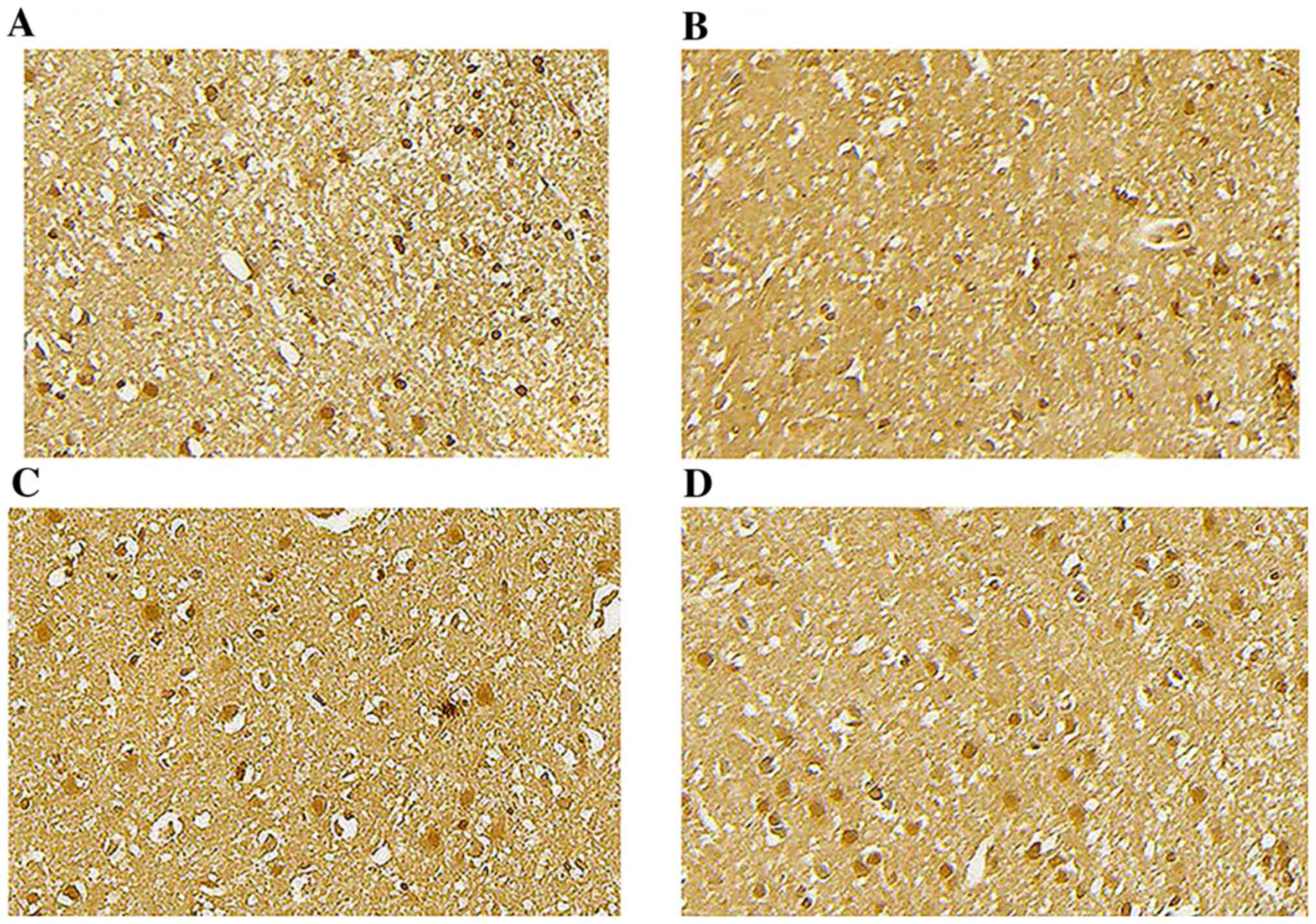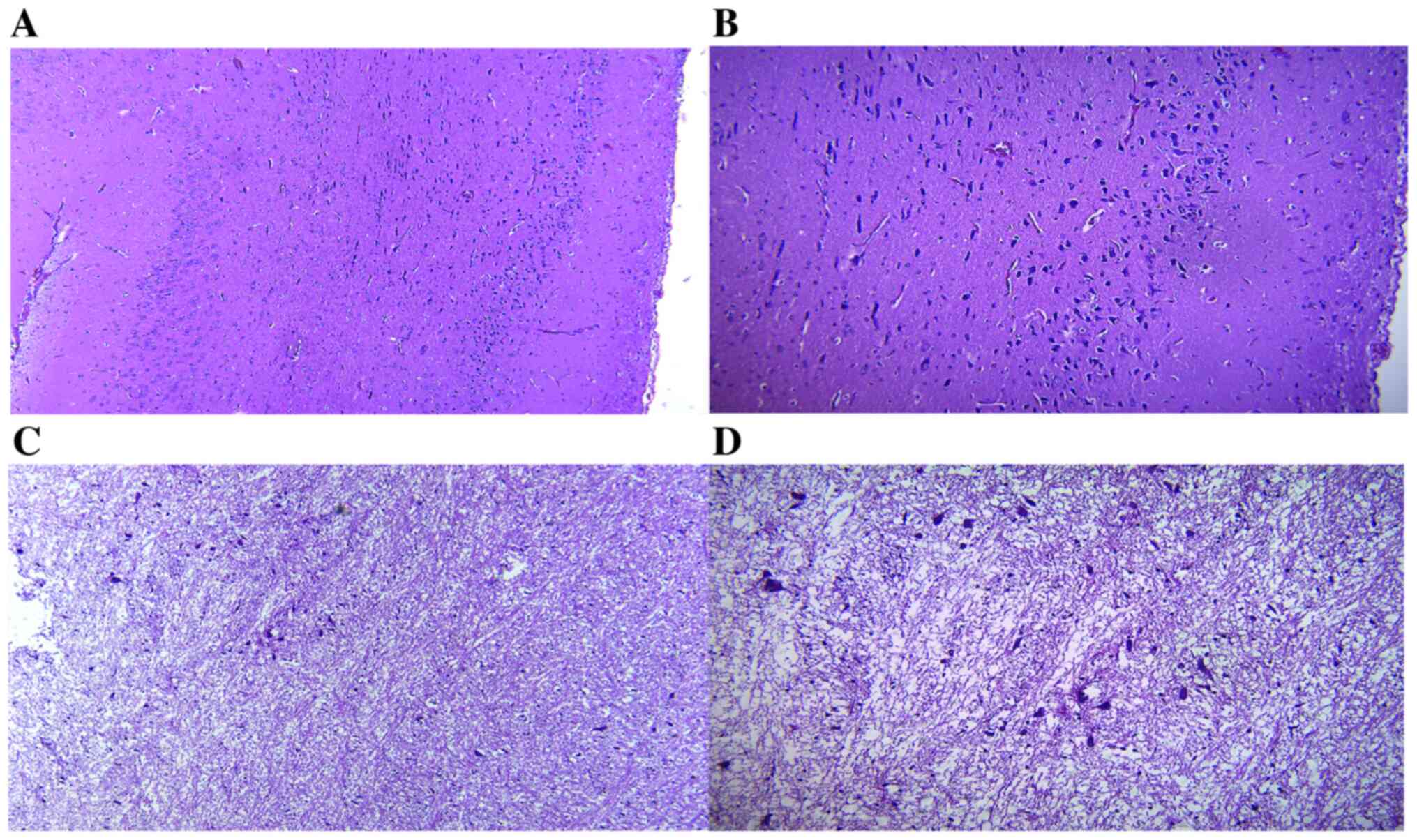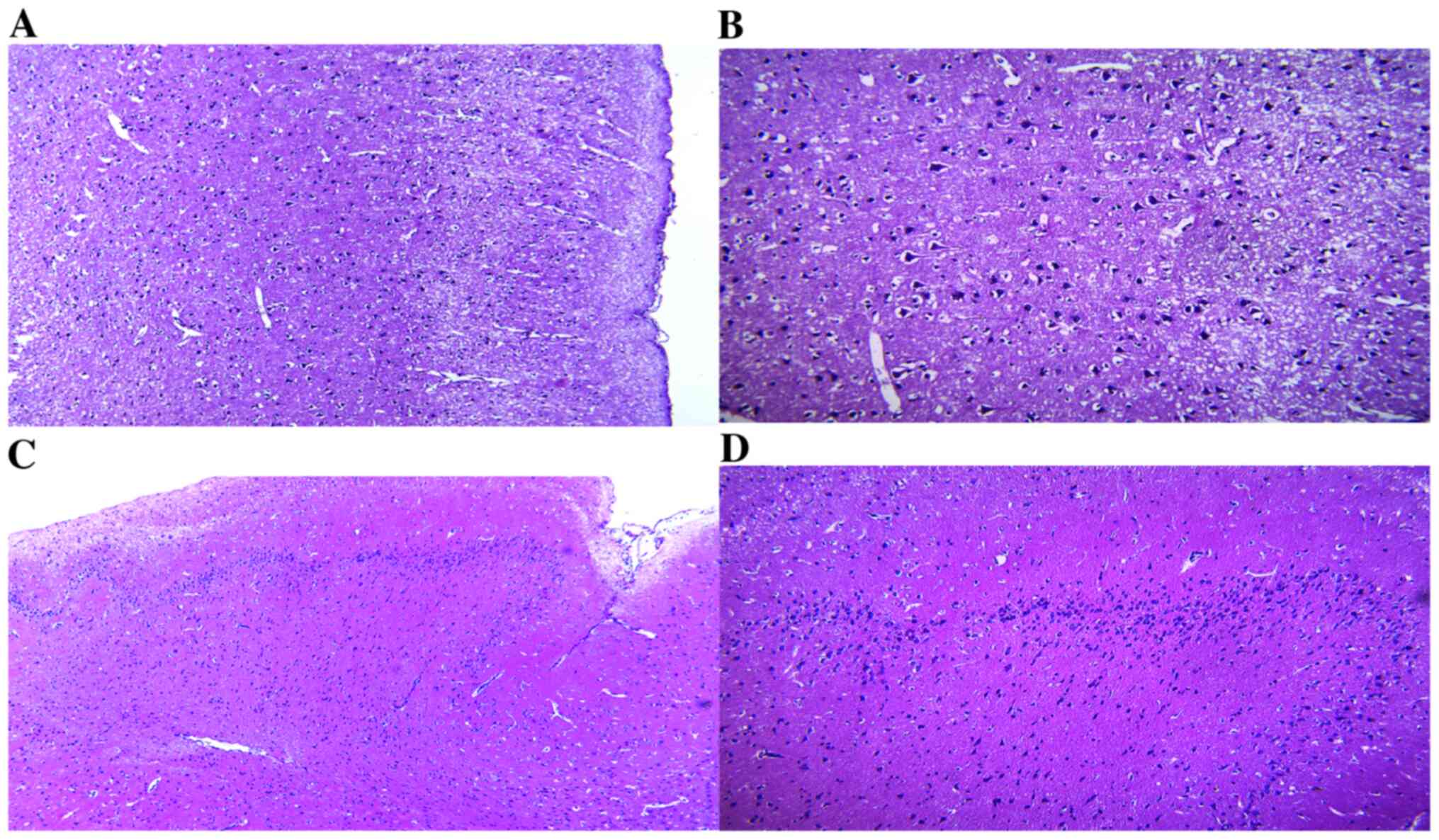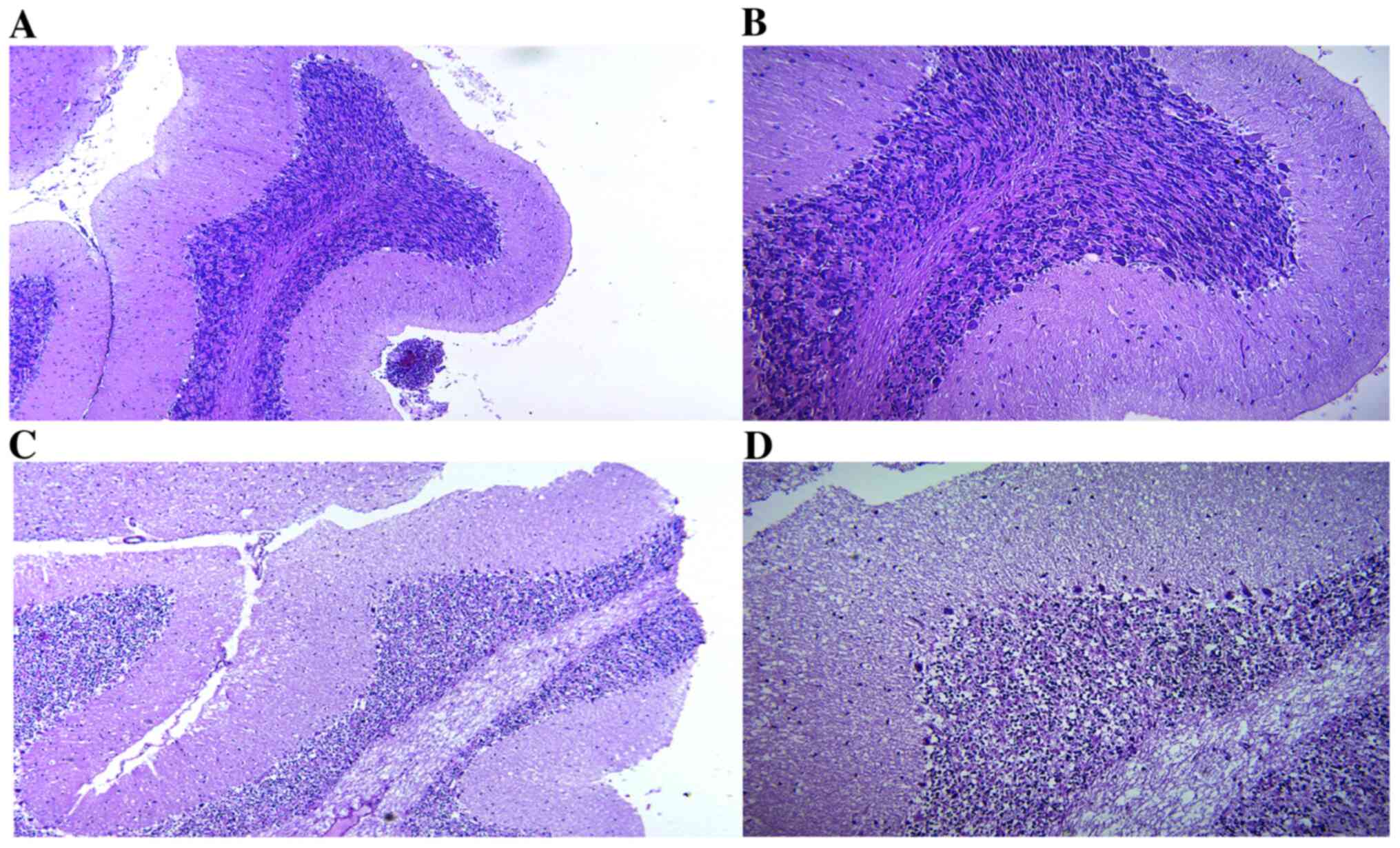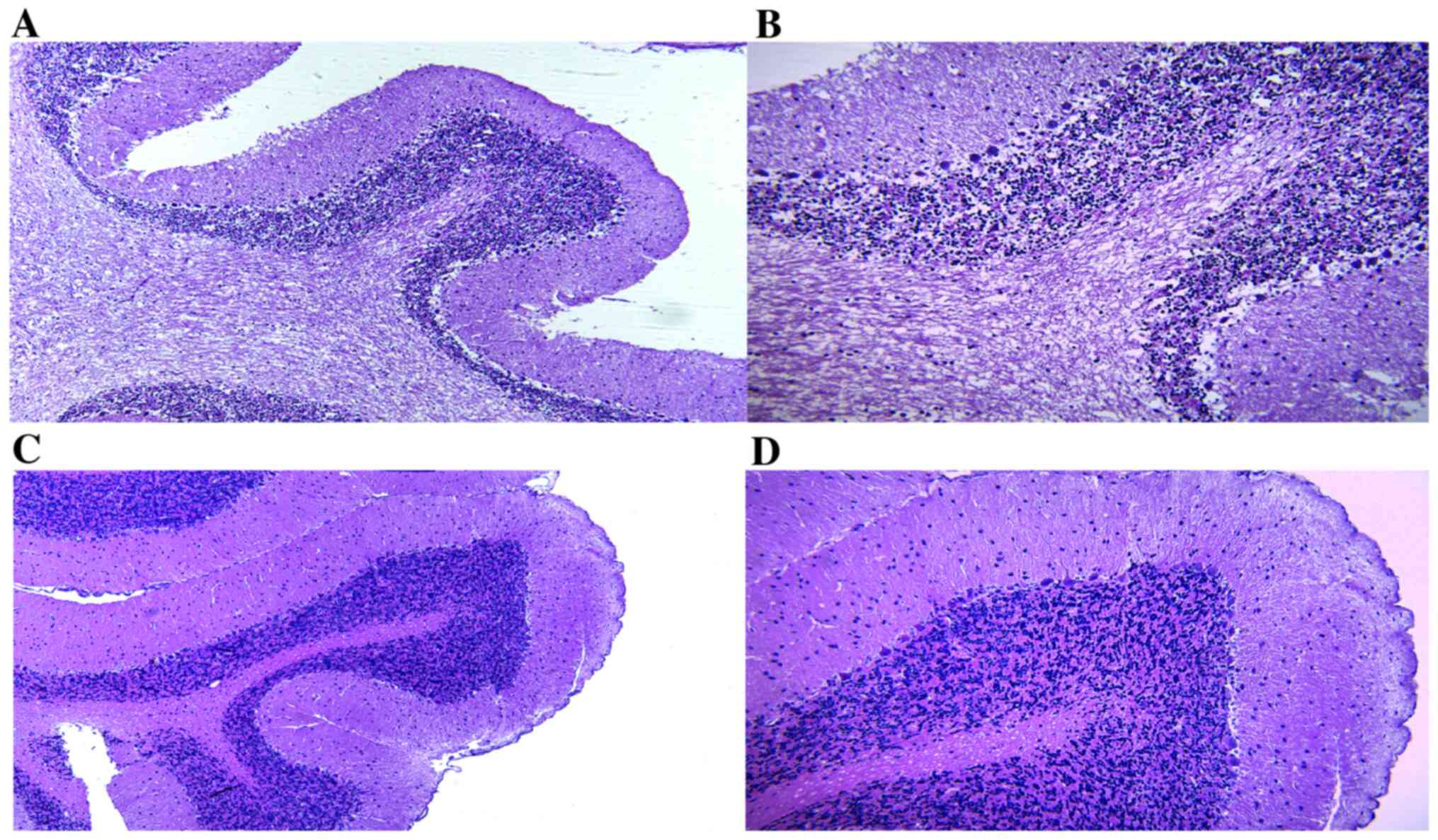Introduction
Telomerase is a ribonucleoprotein enzyme which
functions as a reverse transcriptase to maintain the length of
telomeres, by adding tandem short-sequence repeats at the end of
chromosomes, thus compensating for the loss of deoxyribonucleic
acid (DNA) during genome replication. It consists of the protein
telomerase reverse transcriptase (TERT) and the telomerase RNA
component (TERC), which facilitate telomere synthesis and is
regulated by several proteins that are bound to TERT and TERC,
forming the enzymatically active telomerase (1). In addition, TERT has been reported
to perform additional to telomere elongation functions, including
its translocation to the mitochondria and its contribution to the
decrease in oxidative stress-related complications upon the
accumulation of reactive oxygen species (ROS) (2). It has been demonstrated that upon
increased levels of oxidative stress or other less common stimuli,
TERT is located in the mitochondria where it reduces mitochondrial,
as well as nuclear DNA damage (3), enhances the natural antioxidant and
detoxification cellular mechanisms (4) and improves respiratory chain
function, thereby reducing ROS production (5,6).
Telomerase is inactive or expressed at low levels in the majority
of somatic cells; however, an increased activity is observed in
highly proliferating cells, such as adult stem cells, male sperm
cells, activated lymphocytes and some epidermal cells (7,8).
Consequently, somatic cells have a definite number of divisions,
upon which they become senescent or undergo apoptosis through a
mechanism that involves telomeres and the DNA damage response
(9). Briefly, telomeres are DNA
sequences at the very end of chromosomal DNA consisting of the
TTAGGG pattern, bound to the shelterin proteins, forming a
DNA-protective structure known as the T-loop (10). This structure protects the coding
DNA sequences lying before the telomeres from exonuclease activity
or DNA damaging agents (11).
However, telomere length decreases with each cell replication by
several hundred bases due to the inability of DNA polymerase to
replicate the 3′ telomeres and maintain their length to the
daughter DNA strands. Telomeres shorten gradually up to a critical
point at which they signal cell proliferation arrest to prevent
cellular and DNA damage (12).
Senescent or dying cells are replaced by somatic stem cells of the
respective tissue to maintain tissue function. The dominant
hypothesis of aging and age-related diseases suggests that the
shortening of the telomeres of somatic stem cells hampers their
tissue renewal capacity, which leads to the accumulation of
senescent cells in the tissue and, respectively, to the aged
phenotype of the tissue (13).
Neurodegenerative disorders, such as Alzheimer's
disease (AD) and Parkinson's disease (PD), are characterized by the
progressive loss of neurons that ultimately leads to the decline of
brain function, and the deterioration of cognition and/or locomotor
activity (14,15). Among the main risk factors of
such disorders is the accumulation of protein aggregates, such as
α-synuclein, amyloid-β and pathological tau proteins, as well as
oxidative stress and mitochondrial dysfunction (16-18). Epigenetic modifications have been
suggested to regulate neuroinflammation and subsequent
neurodegeneration. Thus, several epigenetic biomarkers have emerged
in brain diseases, such as patterns of methylation and the
expression of specific microRNAs (miRNAs/miRs), as well as the
levels of serum extracellular vesicle-derived circular RNAs
(19,20). The epigenome is dynamically
regulated through diet and lifestyle, thus opening a novel avenue
for neurodegenerative disorder therapeutics through the combination
of pharmaceutical and nutritional strategies (21,22).
Of note, a short telomere length has been shown to
be associated with poor cognitive function and neurodegenerative
diseases. Although the etiopathogenesis of neurodegenerative
diseases has yet to be fully elucidated, telomere attrition and
telomerase expression have emerged as novel mechanisms and
potential therapeutic targets (19). Several telomerase activators
exist, including both natural and synthetic compounds, acting
through genetic manipulation mediated by adeno-associated viruses.
A widely known natural compound is TA-65® containing
Astragalus membranaceus extract that has been shown to
activate telomerase and to be associated with longer telomeres of
peripheral blood monocytes and improved health parameters (20). Further analysis has demonstrated
that cycloastragenol is the active compound responsible for the
increased telomerase activity. Other known telomerase activators
include product B, a combination of antioxidants, and the synthetic
GRN510, which has a similar structure to cycloastragenol (21). A previous comparative in
vitro analysis of natural compounds identified a novel
telomerase activator 08AGTL formulation containing Centella
asiatica extract; this formulation was found to induce
telomerase activation by up to 8.8-fold compared with 2.2-fold in
cells treated with TA-65® (22). The present study aimed to
investigate the potency of the novel natural formulation 'Reverse™'
containing Centella asiatica extract, vitamin C, zinc and
vitamin D3 on telomerase expression and telomerase activity in the
brains of rats.
Materials and methods
Animal study design
Male Sprague-Dawley rats (n=6; 3 months old, with a
body weight between 320 and 380 g) and 18 male Sprague-Dawley rats
(18 months old, with a body weight between 500 and 580 g) obtained
from the Animal Facility of the University of Medicine and Pharmacy
of Craiova (Craiova, Romania) were included in the present study.
The animal experiments were performed according to the EU Directive
2010/63/E.U. as amended by Regulation E.U.2019/1010 regarding
animal experiments and approved by the Ethics Committee of the
University of Medicine and Pharmacy of Craiova, Craiova Romania
with the license no. 102/23.09.2019. Prior to the start of the
experiment, the animals were allowed to acclimatize to their
environment for 2 weeks. The animals were housed 2-3 animals per
cage, with a 12-h dark/light cycle, and a constant humidity (50±5%)
and temperature (21±2°C). During the study, the animals had free
access to standard animal diet and tap water.
The animals were divided into four groups, with 6
animals per group, and received the treatment once per day via
gavage for a period of 3 months, as presented in Table I. Based on power analysis, the
minimum number of animals per group was estimated at 5; however,
due to the fact that the experiments included middle-aged animals,
6 animals per group were used to prevent the unexpected loss of
animals. The workflow of the study is presented in Fig. 1.
 | Table IGroups and corresponding treatments
in the present study. |
Table I
Groups and corresponding treatments
in the present study.
| Animal groups | Young control,
(n=6) | Old-aged control,
(n=6) | Old-aged group 1,
(n=6) | Old-aged group 2,
(n=6) |
|---|
| Age of the animals
at the beginning of the study (months) | 3 | 18 | 18 | 18 |
| Treatments | Corn oil | Corn oil | 1 capsule/kg body
weight of 'Reverse™' (Natural Doctor S.A) | 2 capsules/kg body
weight of 'Reverse™' (Natural Doctor S.A) |
Treatment and dose selection
The treatment consisted of the administration of the
'Reverse™' supplement (Natural Doctor S.A), notified as a food
supplement (Notification no. 6704/21-1-2020) at the Greek National
Organization for Medicines under current legislation for food
supplements.
The details regarding the dose selection have been
previously described (10).
Briefly, the animals from the treatment groups received 1 or 2
capsules/kg body weight/day of the 'Reverse™' supplement suspended
in corn oil at a final volume of 1.5 ml. Each capsule contains 9 mg
Centella asiatica (L.) extract [consisting of a >90% high
purity single chemical entity, as assessed by high-performance
liquid chromatography and gas chromatography (data not shown)],
vitamin C (200 mg as magnesium ascorbate), zinc (5 mg as zinc
citrate) and vitamin D3 (50 µg as cholecalciferol) per capsule.
The administered doses and treatment duration were
in accordance with clinical recommendations relative to body weight
and with respect to previous studies for vitamin C (23,24), vitamin D3 (25,26) and zinc (27). For Centella asiatica, no
established clinical recommendations exist and the administered
dose in the present study was markedly lower than that used in
previous research (28).
The doses used for the rats were converted from
those used for humans using the factor method. The allometric
scaling approach, following the Food and Drug Administration
guide-lines, was applied for calculations and more specifically,
the correction factor (km) for rats used was equal to 6.2 and the
safety factor value for converting rat doses to humans was equal to
10 (29). The dose values, as
previously described (10) were
calculated as follows: Rat dose = human dose ×6.2×10, where human
dose = 1/60 capsule/kg/body weight (reference human body weight =
60 kg (29).
For treatment group 1 corresponding to the human
dose of 1 capsule/day, the rat dose = 1/60×6.2×10=1.03
capsule/kg/body weight, approximate to 1 capsule/kg/body weight per
rat. For treatment group 2, the rat dose = 2/60×6.2×10=2.06
capsule/kg/body weight, approximate to 2 capsules kg/body weight
per rat.
The animals from the young and old-aged control
group received only corn oil used as a solvent in a volume of 1.5
ml once per day. The duration of the administration was set as 3
months that correspond to subchronic administration for rats. This
was set based on a previous study by the authors using healthy
human volunteers and using other vitamin supplements, where it was
demonstrated that the modulation of telomerase and telomere length
is usually observed following 6-12 months of treatment (7).
Brain collection
Following 3 months of treatment, the animals were
sacrificed by exsanguination from the abdominal aorta under 5%
sevoflurane anesthesia. The brains were collected, and half were
formalin-fixed for evaluation using immunohistochemistry and
histopathology, and the other half of the cortex and cerebellum
were separated and shock-frozen in small sections in liquid
nitrogen and kept −80°C until further analysis.
Telomerase activity assay
Telomerase activity in the cortex and cerebellum was
measured using a commercial rat telomerase PCR-ELISA (TeloTAGGG
Telomerase PCR ELISA PLUS; cat. no. 12 013 789 001, Roche
Diagnostics), based on a photometric enzyme immunoassay for
quantitative determination utilizing a telomeric repeat
amplification protocol (TRAP) (30). TRAP reaction was performed
according to the manufacturer's protocol using the Applied
Biosystems PCR system (30 cycles at 50°C; cat. no. 4485701; Applied
Biosystems; Thermo Fisher Scientifiic, Inc.); the reactions were
performed in triplicate. The detection of amplicons was further
quantified using ELISA (StatFax 4700 ELISA reader system, Awareness
Technology, Inc.). The absorbance values are reported as the A450nm
reading against the blank. The mean of the absorbance reading of
the negative control from those of the sample was extracted.
Samples are regarded as telomerase-positive if the difference in
the absorbance was >0.2 units.
TERT protein expression assay
The TERT levels in the cortex and cerebellum were
measured using a commercial rat TERT sandwich ELISA kit (cat. no.
SEC241Ra; Cloud-Clone Corp.) according to the manufacturer's
instructions. Brain tissue homogenate was prepared as follows:
After microdissection, the brain tissues (cortex and cerebellum)
were weighted and homogenized in 0.5 ml of 0.01 M PBS (pH 7.0)
using a tissue homogenizer on ice. The suspensions were subjected
to two freeze/thaw cycles to further break the cell membranes and
were centrifuged for 5 min at 500 × g at 4°C. The supernatant was
stored at −20°C until analysis (no more than 1 month).
TERT assay was performed using 100 µl
supernatant, according to the manufacturer's instructions and
measured spectrophotometrically at a wavelength of 450 nm using an
ELISA reader system (StatFax 4700, Awareness Technology, Inc.). The
samples were examined in triplicate. The concentration of TERT
expression in the sample was then determined by comparing the
absorbance of the sample to the standard curve and normalized
according to the protein concentration measured using Bradford
reagent (Sigma-Aldrich).
Determination of TERT expression in brain
tissue using immunohistochemistry
To analyze TERT expression in brain tissue,
formalin-fixed, paraffin-embedded brain tissue was used. Brain
tissue sections (10-µM-thick) were deparaffinized and
rehydrated in successive steps with a decreasing concentration of
methanol. Antigen retrieval was performed using 1 mM citrate buffer
by microwaving for 10 min at 95°C. Immunohistochemistry was
performed as follows: i) The sections were blocked in PBS
containing 10% normal goat serum at room temperature for 1 h; ii)
the sections were incubated overnight at 4°C with primary
polyclonal rabbit anti-TERT antibody (diluted 1:100; cat. no.
BS0233R, Bioss Antibodies); iii) appropriate universal
immune-peroxidase polymer, anti-rabbit was applied
(Histofine® Simple Stain Max PO anti-rabbit; diluted
1:10; cat. no. 414141F, Nichirei Bioscience) for 30 min at room
temperature. Following staining with 3,3′-diaminobenzidine (DAB;
Vector Laboratories, Inc.), the sections were dried overnight at
37°C and covered using mounting medium (Vector Laboratories, Inc.).
The visualization and image collection of the slides was performed
using a Nikon 90i motorized microscope equipped with a DS-Ri2 16 MP
complementary metal oxide semiconductor (CMOS) camera and the Nikon
NIS Elements AR software package Ver5.11.03 (Nikon
Corporation).
Histopathological evaluation
Brain tissue was collected and kept for 48 h in a 4%
paraformaldehyde solution. The samples were successively dehydrated
in solution with increasing concentrations of ethanol (1 h in 70%
solution, 1 h in 90% solution and 5 h in 100% solution) and then
cleared in xylene for 2 h. The tissue was then embedded in
paraffin. From the paraffin block, sections of 25 µm
thickness were cut and stained with hematoxylin and eosin
(Sigma-Aldrich) according to the standard protocol (31). The histopathological examination
was performed under the Panthera L research microscope (Motic
Europe, S.L.U.) with the licensed Panthera L photo-micrographic
image acquisition software Motic Images Plus 2.0ML for Microsoft
Windows Legacy Version w/o MI Devices (Motic Europe, S.L.U.).
Statistical analysis
Statistical analysis was performed using GraphPad
Prism version 5.0 software for Windows (GraphPad Software, Inc.).
One-way analysis of variance (ANOVA; parametric) for independent
samples was used for the comparisons of the mean values for more
than two independent groups. One-way ANOVA was followed by post hoc
analysis using the Bonferroni adjusted t-test. A P-value ≤0.05 was
considered to indicate a statistically significant difference.
Results
Telomerase activity
The telomerase activity levels were significantly
lower in the brain cortex of the old-aged control group (0.17±0.01;
P<0.05) compared with the young control group (0.25±0.01;
P<0.05) at 3 months following the initiation of the study.
Similar results were revealed by the analysis of the cerebellum
where the telomerase activity levels were significantly lower in
the old-aged control group (21 months old) compared with the young
control group (0.15±0.02 vs. 0.26±0.02; P<0.05) at 3 months
following the initiation of the study. The telomerase activity
levels were significantly increased in the old-aged groups that
received the 'Reverse™' supplement compared with the untreated
old-aged control group, both in the cortex and cerebellum
(P<0.05). No significant differences were observed in the
telomerase activity between the old-aged groups 1 and 2, and the
young control group (Fig.
2).
TERT protein level
The TERT protein levels were significantly lower in
the old-aged control group compared with the young control group in
both the cortex and cerebellum (P<0.05; Fig. 3). Treatment with 2 capsules/kg
body weight of the 'Reverse™' supplement for 3 months resulted in a
significant increase in TERT protein levels in the old-aged group 2
compared with the old-aged control group in both the cortex and
cerebellum (P<0.05; Fig. 3).
No statistically significant differences in TERT protein levels
were observed between the old-aged control group and old-aged group
1 in both the cortex and cerebellum tissue (Fig. 3). Staining with anti-TERT
antibody revealed that TERT immunoreactivity was present in the
cytoplasm and nucleus of the brain cells in the rat cortex stained
with DAB (Fig. 4).
Histopathological evaluation
Histopathological aspect of the cerebral
cortex
The microscopic evaluation of the rat cerebral
cortex of the old-aged control group, revealed an increase in edema
that dissociated the layers of the cerebral cortex and appeared as
an unequal distribution with cytoarchitectonics modified by poor
neuronal cellularity. Several different areas of each cerebral
cortex were observed and the results were similar; thus, the most
representative images are presented (Fig. 5C and D). By contrast, the young
control group exhibited a normal microscopic structure (Fig. 5A and B). Treatment with 1
capsule/kg body weight of the 'Reverse™' supplement for 3 months
led to a slight decrease in edema; however, the cytoarchitectonic
structure remained altered and a poor neuronal cellular
distribution was observed (Fig. 6A
and B). In the old-aged group 2, following treatment with 2
capsules/kg body weight of the 'Reverse™' supplement for 3 months,
the cytoarchitecture of the cerebral cortex appeared relatively
normal, similar to the differentiation observed in the young
control group and the edema was discrete in the intermediate layers
of the cerebral cortex (Fig. 6C and
D).
Microscopic aspect of the cerebellar
cortex
The microscopic evaluation of the rat cerebellar
cortex of the old-aged control group revealed an increase in edema
that dissociated the layers of the cerebellar cortex; a modified
cytoarchitecture was also observed that was accentuated at the
level of the cerebellar layers, although not in the same measure as
the one identified in the cerebral cortex. Several different areas
of each cerebellar cortex were observed and the results were
similar; thus, the most representative images are presented
(Fig. 7C and D). By contrast,
the young control group exhibited a normal microscopic structure
(Fig. 7A and B). In the group
treated with 1 capsule/kg body weight of the 'Reverse™' supplement
for 3 months (old-aged group 1) the modified cytoarchitecture at
the level of the cerebellar layers, through edema, remained and the
effects were slightly milder compared with the those in the
old-aged control group (Fig. 8A and
B). In old-aged group 2 that received 2 capsules/kg body weight
of the 'Reverse™' supplement for 3 months, the cytoarchitecture of
the cerebellar cortex was relatively normal, similar to the
differentiation observed in the young control group, and the edema
was discrete in the intermediate layers of the cerebellar cortex
(Fig. 8C and D).
Discussion
The present study aimed to investigate the activity
of telomerase and the expression of TERT in the brains of rats
treated with a novel telomerase activator containing Centella
asiatica extract, vitamin C, zinc and vitamin D3 for 3
months.
Brain ageing is a key risk factor and mechanism
responsible for a number of neurodegenerative diseases (32,33), and it has been demonstrated that
telomerase activity and TERT abundance may play a protective role
in neurons and brain cell functions (34).
To the best of our knowledge, the present study
demonstrates for the first time that the administration of the
dietary supplement 'Reverse™' containing Centella asiatica
extract, vitamin C (as magnesium ascorbate), zinc (as zinc citrate)
and vitamin D3 (as cholecalciferol), to 18-month-old rats for 3
months, restores the decline in TERT expression and enhances
telomerase activity. The findings presented herein demonstrated
that the administration of the dietary supplement 'Reverse™'
resulted in a moderate increase in TERT expression, and the
telomerase activity was highly increased between old-aged groups 1
and 2, and the young control group. The findings also demonstrated
that the activation of telomerase activity could be achieved
despite the limited increase in TERT expression. However, further
studies using larger-sized groups are warranted to establish
whether there is a dose-response association. These findings are in
line with those in a previous study by the authors which
demonstrated that 'Reverse™' improved motor performance and
decreased the stress levels of rats (10).
Specifically, in the present study, telomerase
activity and TERT expression were shown to be significantly lower
in 21-month-old rats compared with 6-month-old rats in both the
brain cortex and cerebellum, suggesting the age-dependent
expression of TERT in rats, in line with other findings (10). The TERT levels regulate
telomerase activity, and it has been described that telomerase
activity decreases during embryo-genesis. By contrast, the TERT
levels are maintained, at least in humans, possibly to protect
neurons from oxidative stress and neurodegeneration (34).
The dose of 1 capsule of 'Reverse™' supplement per
kg body weight per rat (old-aged group 1) resulted in a
statistically significant increase in telomerase activity in the
cortex and cerebellum of 21-month-old rats. Comparable results were
obtained for TERT expression, although these did not reach
statistical significance. The effect was more evident with the
2-capsule dose (old-aged group 2) where the levels of telomerase
activity were significantly higher than those in the old-aged
control group, reaching the levels of the young group both in the
cortex and the cerebellum of the rats. Accordingly, the TERT
expression levels were higher in the old-aged group 2 than in the
old-aged group 1 and the old-aged control group. Anti-TERT
immunohistochemistry staining in the cortex and cerebellum tissue
slides confirmed the aforementioned results. These findings suggest
that the oral administration of 2 capsules/kg body weight per rat
of the 'Reverse™' dietary supplement is more effective for
telomerase activation and TERT level restoration in the brain than
the 1 capsule dose.
The same microscopic changes produced by aging were
noted following the comparative analysis performed on the cerebral
and cerebellar cortex. The edema was constant and accentuated in
both types of cortex with a modified cytoarchitecture and poor
neuronal cellularity in the 21-month-old rats. Previous research
supports these findings. Desbordes and Cohadon (35) demonstrated that in rat brains,
cellular swelling increased with aging, while extracellular edema
was less evident. These findings can be explained by the decreased
activity of Na+-K+-ATPase activity. It has
been demonstrated that at 3 months of age, which corresponds to the
end of adolescence, rats reach the peak number of neurons both in
the cerebellum and cortex. From this age on, the progressive
decline in the number of neurons commences (36). Morterá and Herculano-Houzel
(37) demonstrated that by 22
months of age, the decrease in neurons in the cerebellum and cortex
of rats is almost 30% less than the value observed at the age of 3
months. In the present study, the administration of 1 capsule/kg
body weight of the 'Reverse™' supplement for 3 months exerted only
a slight beneficial effect on the decline in the number of neurons.
The administration of 2 capsules/kg body weight of the 'Reverse™'
supplement for 3 months to the 18-month-old rats (old-aged group 2)
exerted a structural reversibility effect close to the
differentiation of the gray matter from the young control group
that is explained by telomerase activation and the restoration of
TERT levels in the brain observed in this group. It has been
demonstrated that TERT inhibits the death of cells and promote the
survival of neurons (38). Even
if neurons are non-dividing cells, telomerase expression in neurons
plays an additional role in regulating apoptosis beyond its
function in telomere maintenance (39).
Previous studies on telomerase expression
enhancement in the brain have been conducted either via genetic
intervention or by the use of synthetic or natural enzyme
activators, as reviewed by Saretzki and Wan (34). As regards natural activators,
TA-65® and GRN510 have yielded encouraging results on
the beneficial effects of telomerase activation on brain function.
Specifically, as previously demonstrated, the administration of
TA-65® to aged mice ameliorated several physiological
parameters, including neuromuscular coordination and cognition
accompanied by the increased expression of the mouse TERT
(mTERT). Furthermore, treatment with TA-65® and
GRN510 yielded similar results in brain-specific TERT expression,
but only TA-65® decreased mitochondrial ROS accumulation
and α-synuclein aggregates (40). However, telomerase activation
with TA-65®, which contains Astragalus
membranaceus extract, has been shown to be significantly lower
than with formulations including Centella asiatica extract
(22). 'Reverse™' is a dietary
supplement containing Centella asiatica extract, vitamin C,
vitamin D3 and zinc, constituents with known antioxidant properties
previously described in terms of their relevance to the present
study (10). In particular,
Centella asiatica has been shown to exert neuro-protective
effects, while enhancing cognitive function (41). Vitamin C and zinc have been
reported to play a neuroprotective role and function
synergistically to improve synaptic activity and detoxification,
and to maintain the physiological function of protein degradation
mediated by ubiquitin (42).
Vitamin D deficiency is a known and well-described risk factor for
several neurodegenerative diseases (43,44). Vitamin D has been described as a
key neuroprotector through its role as an immunomodulator, a
regulator of calcium levels in neurons and a mediator of the
detoxification mechanism (45,46). Telomerase activity has been
reported to be enhanced in previous in vivo studies on
vitamin C, vitamin D, zinc and Centella asiatica (47,48). However, additional studies are
required to determine whether the combination of these compounds
acts synergistically in terms of telomerase activation and to
investigate the underlying molecular mechanisms. Overall, the
beneficial effects of natural products on oxidative stress and
inflammation is a widely studied field; thus, they have emerged as
potential therapeutic targets in several neurodegenerative
disorders. Indeed, there is evidence to indicate that
phytochemicals, such as polyphenols, found in pomegranate (47), aloe vera, red fruits and other
natural products are important for normal brain function (15,17,49-51). Detailed analyses of the different
modes of action of natural phytochemicals in AD have suggested that
certain compounds may serve as potent therapeutic agents as they
are effective, easy-to access, safe and lower-cost options compared
to other drugs (14,32,52,53).
Although not aiming to extrapolate the present
findings, it may be noted that the beneficial effects of 'Reverse™'
on telomerase/TERT levels may be mediated by the reduction of
oxidative stress in the brain microenvironment through the
synergistic effects of the formulation constituents. However, a
limitation of the present study is the lack of oxidative stress
damage measurements and the comparative analysis of separate
compounds contained in 'Reverse™' to validate this hypothesis. As
regards the synergy of nutrients, there is significant evidence to
indicate that combined treatment with nutraceuticals may prove to
be extremely useful in the management of age-related diseases
(49,54,55). Specifically for brain health, it
has been demonstrated that the administration of a multi-nutrient
supplement can prevent brain ischemia more potently than single
nutrients in vitro (56). Future
studies are required however to validate the additive effects of
'Reverse™' constituents on TERT expression and telomerase activity.
Further studies are also required to investigate the association
between telomere length, telomerase activity and motor function
post-treatment with 'Reverse™', to provide mechanistic insight into
aging prevention and management strategies for common
neurodegenerative diseases.
The clinical relevance of the present study refers
to the potency of 'Reverse™' to increase TERT expression and
telomerase activity in the brains of middle-aged rats. Middle-aged
rats at 18 months old correspond to 45-year-old humans; thus, rats
at this age represent a good experimental model to examine the
effects of the intervention on the early-aged brain that could be
used as a tool to delay neurodegenerative diseases (57). The results of the present study
demonstrate that the increase inh TERT expression in the brains of
middle-aged rats and the increase in telomerase activity can be
achieved through nutraceutical supplementation, and not only in the
postnatal or embryonic period [when central nervous system (CNS)
development occurs]. The reactivation of such path-ways that are
active during CNS development can improve functional outcomes
following brain lesions, such as stroke or neurodegenerative
diseases, and may prove to play a crucial role in the management of
a number of CNS diseases.
AD and PD are slowly progressive neurodegenerative
disorders that occur upon irreversible brain damage, extensive
inflammation and oxidative stress, leading to dementia and
motor/non-motor traits, respectively. In AD, telomere attrition
emerges as a critical mechanism possibly related to the increased
oxidative stress that precedes the accumulation of amyloid and
neurofibrillary tangles (58).
TERT expression inversely correlates with tau expression in
neurons, indicating an oxidative stress-mediated mechanism of AD.
AD can occur during the later or early stages of life (known as
early-onset AD) and occurs prior to the age of 60. There is
evidence to indicate that midlife interventions focusing on
modifiable risk factors can prevent dementia (59). Accordingly, PD etiopathogenesis
includes the accumulation of α-synuclein caused by folding
impairment and its defective clearance through the autophagic
pathway. It has been demonstrated that telomerase activators can
successfully facilitate the normal function of autophagy and the
reduction of protein aggregates, possibly mediated by the increase
in TERT levels. In addition, TERT is known for its non-canonical
function as an antioxidant defense mediator, which further supports
the physiological protein post-translational folding and
mitochondrial function (60).
In conclusion, to the best of our knowledge, the
present study provides the first evidence of the potency of a novel
telomerase activator based on the formulation 'Reverse™' containing
Centella asiatica extract, vitamin C, vitamin D3 and zinc as
a treatment against brain aging and related disorders using an
in vivo animal model. These results may have a positive
impact on the management of a number of CNS diseases. However, they
need to be further validated in clinical trials to establish the
dosing and duration in order to achieve the optimal therapeutic
effects.
Availability of data and materials
The datasets used and/or analyzed during the current
study are available from the corresponding author on reasonable
request.
Authors' contributions
DC and DT designed the study and wrote the
manuscript as a special part of a PhD thesis from the University of
Medicine and Pharmacy of Craiova, Romania. AMB, AOD, ES, RM, ER,
LC, DAS, IR and MN performed the analyses, statistical analysis and
presentation of the results and wrote the manuscript. DT, AT, DAS,
IR, AMB, MN and DC critically reviewed the text and prepared the
figures. AT, AOD, AMB and DC critically assessed the design of the
study and the interpretation of the findings. DT, AMB, AOD confirm
the authenticity of all the raw data. All authors have read and
approved the final version of the manuscript.
Ethics approval and consent to
participate
The present study was conducted according to the
guidelines of the Declaration of Helsinki, and approved by the
Ethical Committee of the University of Medicine and Pharmacy of
Craiova, Craiova, Romania (no. 102/23.09.2019). All the procedures
used in this experiment were according to the European directives
for the animal experiments (EU Directive 2010/63/EU as amended by
Regulation EU 2019/1010).
Patient consent for publication
Not applicable.
Competing interests
DAS is the Editor-in-Chief for the journal, but had
no personal involvement in the reviewing process, or any influence
in terms of adjudicating on the final decision, for this article.
DT is a scientific advisor for Natural Doctor S.A. The other
authors declare that they have no competing interests.
Acknowledgments
Not applicable.
Funding
No funding was received.
References
|
1
|
de Lange T: T-loops and the origin of
telomeres. Nat Rev Mol Cell Biol. 5:323–329. 2004. View Article : Google Scholar
|
|
2
|
Miwa S, Czapiewski R, Wan T, Bell A, Hill
KN, von Zglinicki T and Saretzki G: Decreased mTOR signalling
reduces mitochondrial ROS in brain via accumulation of the
telomerase protein TERT within mitochondria. Aging (Albany NY).
8:2551–2567. 2016. View Article : Google Scholar
|
|
3
|
Singhapol C, Pal D, Czapiewski R, Porika
M, Nelson G and Saretzki GC: Mitochondrial telomerase protects
cancer cells from nuclear DNA damage and apoptosis. PLoS One. 8.
pp. e529892013, View Article : Google Scholar
|
|
4
|
Martens A, Schmid B, Akintola O and
Saretzki G: Telomerase Does Not Improve DNA Repair in Mitochondria
upon Stress but Increases MnSOD Protein under Serum-Free
Conditions. Int J Mol Sci. 21:212019. View Article : Google Scholar
|
|
5
|
Rosen J, Jakobs P, Ale-Agha N, Altschmied
J and Haendeler J: Non-canonical functions of Telomerase Reverse
Transcriptase - Impact on redox homeostasis. Redox Biol. 34:101543.
2020. View Article : Google Scholar
|
|
6
|
Padureanu R, Albu CV, Mititelu RR,
Bacanoiu MV, Docea AO, Calina D, Padureanu V, Olaru G, Sandu RE,
Malin RD, et al: Oxidative Stress and Inflammation Interdependence
in Multiple Sclerosis. J Clin Med. 8:112019. View Article : Google Scholar
|
|
7
|
Tsoukalas D, Fragkiadaki P, Docea AO,
Alegakis AK, Sarandi E, Vakonaki E, Salataj E, Kouvidi E, Nikitovic
D, Kovatsi L, et al: Association of nutraceutical supplements with
longer telomere length. Int J Mol Med. 44:218–226. 2019.
|
|
8
|
Tsoukalas D, Fragoulakis V, Sarandi E,
Docea AO, Papakonstaninou E, Tsilimidos G, Anamaterou C,
Fragkiadaki P, Aschner M, Tsatsakis A, et al: Targeted Metabolomic
Analysis of Serum Fatty Acids for the Prediction of Autoimmune
Diseases. Front Mol Biosci. 6:1202019. View Article : Google Scholar
|
|
9
|
Tsoukalas D, Sarandi E, Thanasoula M,
Docea AO, Tsilimidos G, Calina D and Tsatsakis A: Metabolic
Fingerprint of Chronic Obstructive Lung Diseases: A New Diagnostic
Perspective. Metabolites. 9:182019. View Article : Google Scholar
|
|
10
|
Tsoukalas D, Zlatian O, Mitroi M, Renieri
E, Tsatsakis A, Izotov BN, Burada F, Sosoi S, Burada E, Buga AM, et
al: A Novel Nutraceutical Formulation Can Improve Motor Activity
and Decrease the Stress Level in a Murine Model of Middle-Age
Animals. J Clin Med. 10:6242021. View Article : Google Scholar
|
|
11
|
Palm W and de Lange T: How shelterin
protects mammalian telomeres. Annu Rev Genet. 42:301–334. 2008.
View Article : Google Scholar
|
|
12
|
Victorelli S and Passos JF: Telomeres and
Cell Senescence - Size Matters Not. EBioMedicine. 21:14–20. 2017.
View Article : Google Scholar
|
|
13
|
Carneiro MC, de Castro IP and Ferreira MG:
Telomeres in aging and disease: Lessons from zebrafish. Dis Model
Mech. 9:737–748. 2016. View Article : Google Scholar
|
|
14
|
Calina D, Buga AM, Mitroi M, Buha A,
Caruntu C, Scheau C, Bouyahya A, El Omari N, El Menyiy N and Docea
AO: The Treatment of Cognitive, Behavioural and Motor Impairments
from Brain Injury and Neurodegenerative Diseases through
Cannabinoid System Modulation-Evidence from In Vivo Studies. J Clin
Med. 9:282020. View Article : Google Scholar
|
|
15
|
Salehi B, Sestito S, Rapposelli S, Peron
G, Calina D, Sharifi-Rad M, Sharopov F, Martins N and Sharifi-Rad
J: Epibatidine: A Promising Natural Alkaloid in Health.
Biomolecules. 9:102018. View Article : Google Scholar
|
|
16
|
Salehi B, Quispe C, Chamkhi I, El Omari N,
Balahbib A, Sharifi-Rad J, Bouyahya A, Akram M, Iqbal M, Docea AO,
et al: Pharmacological Properties of Chalcones: A Review of
Preclinical Including Molecular Mechanisms and Clinical Evidence.
Front Pharmacol. 11:5926542021. View Article : Google Scholar
|
|
17
|
Salehi B, Sharifi-Rad J, Cappellini F,
Reiner Ž, Zorzan D, Imran M, Sener B, Kilic M, El-Shazly M, Fahmy
NM, et al: The Therapeutic Potential of Anthocyanins: Current
Approaches Based on Their Molecular Mechanism of Action. Front
Pharmacol. 11:13002020. View Article : Google Scholar
|
|
18
|
Radu G, Bordejevic AD, Buda V, Tomescu MC,
Dragan I, Dehelean L, Cocos IL, Cheveresan A and Andor M:
Cardiovascular risk factors for different types of psychiatric
pathologies. A correlative study Farmacia. 68:835–842. 2020.
View Article : Google Scholar
|
|
19
|
Lex K, Maia Gil M, Lopes-Bastos B,
Figueira M, Marzullo M, Giannetti K, Carvalho T and Ferreira MG:
Telomere shortening produces an inflammatory environment that
increases tumor incidence in zebrafish. Proc Natl Acad Sci USA.
117:15066–15074. 2020. View Article : Google Scholar
|
|
20
|
Liu P, Zhao H and Luo Y: Anti-Aging
Implications of Astragalus membranaceus (Huangqi): A Well-Known
Chinese Tonic. Aging Dis. 8:868–886. 2017. View Article : Google Scholar
|
|
21
|
Harley CB, Liu W, Flom PL and Raffaele JM:
A natural product telomerase activator as part of a health
maintenance program: Metabolic and cardiovascular response.
Rejuvenation Res. 16:386–395. 2013. View Article : Google Scholar
|
|
22
|
Tsoukalas D, Fragkiadaki P, Docea AO,
Alegakis AK, Sarandi E, Thanasoula M, Spandidos DA, Tsatsakis A,
Razgonova MP and Calina D: Discovery of potent telomerase
activators: Unfolding new therapeutic and anti-aging perspectives.
Mol Med Rep. 20:3701–3708. 2019.
|
|
23
|
Institute of Medicine (US) Panel on
Dietary Antioxidants Related Compounds: Dietary Reference Intakes
for Vitamin C, Vitamin E, Selenium, and Carotenoids. National
Academies Press (US); Washington, DC: 2000
|
|
24
|
Sil S, Ghosh T, Gupta P, Ghosh R, Kabir SN
and Roy A: Dual Role of Vitamin C on the Neuroinflammation Mediated
Neurodegeneration and Memory Impairments in Colchicine Induced Rat
Model of Alzheimer Disease. J Mol Neurosci. 60:421–435. 2016.
View Article : Google Scholar
|
|
25
|
Holick MF, Binkley NC, Bischoff-Ferrari
HA, Gordon CM, Hanley DA, Heaney RP, Murad MH and Weaver CM:
Guidelines for preventing and treating vitamin D deficiency and
insufficiency revisited. J Clin Endocrinol Metab. 97:1153–1158.
2012. View Article : Google Scholar
|
|
26
|
Williamson L, Hayes A, Hanson ED, Pivonka
P, Sims NA and Gooi JH: High dose dietary vitamin D3 increases bone
mass and strength in mice. Bone Rep. 6:44–50. 2017. View Article : Google Scholar
|
|
27
|
Institute of Medicine (US) Panel on
Micronutrients: Dietary Reference Intakes for Vitamin A, Vitamin K,
Arsenic, Boron, Chromium, Copper, Iodine, Iron, Manganese,
Molybdenum, Nickel, Silicon, Vanadium, and Zinc. National Academies
Press (US); Washington, DC: 2001
|
|
28
|
Rao SB, Chetana M and Uma Devi P: Centella
asiatica treatment during postnatal period enhances learning and
memory in mice. Physiol Behav. 86:449–457. 2005. View Article : Google Scholar
|
|
29
|
Nair AB and Jacob S: A simple practice
guide for dose conversion between animals and human. J Basic Clin
Pharm. 7:27–31. 2016. View Article : Google Scholar
|
|
30
|
Grin Y, Admoni T and Priel E: Telomerase
activity in the various regions of mouse brain: Non-radioactive
telomerase repeat amplification protocol (TRAP) assay. J Vis Exp.
91:e518652014.
|
|
31
|
Iordache AM, Buga AM, Albulescu D, Vasile
RC, Mitrut R, Georgiadis G, Zisis IE, Mamoulakis C, Tsatsakis A,
Docea AO, et al: Phosphodiesterase-5 inhibitors ameliorate
structural kidney damage in a rat model of contrast-induced
nephropathy. Food Chem Toxicol. 143:1115352020. View Article : Google Scholar
|
|
32
|
Salehi B, Prakash Mishra A, Nigam M,
Karazhan N, Shukla I, Kiełtyka-Dadasiewicz A, Sawicka B, Głowacka
A, Abu-Darwish MS, Hussein Tarawneh A, et al: Ficus plants: State
of the art from a phytochemical, pharmacological, and toxicological
perspective. Phytother Res. 35:1187–1217. 2021. View Article : Google Scholar
|
|
33
|
Aloizou AM, Siokas V, Pateraki G, Liampas
I, Bakirtzis C, Tsouris Z, Lazopoulos G, Calina D, Docea AO,
Tsatsakis A, et al: Thinking outside the Ischemia Box: Advancements
in the Use of Multiple Sclerosis Drugs in Ischemic Stroke. J Clin
Med. 10:192021. View Article : Google Scholar
|
|
34
|
Saretzki G and Wan T: Telomerase in Brain:
The New Kid on the Block and Its Role in Neurodegenerative
Diseases. Biomedicines. 9:4902021. View Article : Google Scholar
|
|
35
|
Desbordes P and Cohadon F: Brain water and
aging. J Gerontol. 42:655–659. 1987. View Article : Google Scholar
|
|
36
|
Spear LP: The adolescent brain and
age-related behavioral manifestations. Neurosci Biobehav Rev.
24:417–463. 2000. View Article : Google Scholar
|
|
37
|
Morterá P and Herculano-Houzel S:
Age-related neuronal loss in the rat brain starts at the end of
adolescence. Front Neuroanat. 6:452012. View Article : Google Scholar
|
|
38
|
Saretzki G: Telomerase, mitochondria and
oxidative stress. Exp Gerontol. 44:485–492. 2009. View Article : Google Scholar
|
|
39
|
Ahmed S, Passos JF, Birket MJ, Beckmann T,
Brings S, Peters H, Birch-Machin MA, von Zglinicki T and Saretzki
G: Telomerase does not counteract telomere shortening but protects
mitochondrial function under oxidative stress. J Cell Sci.
121:1046–1053. 2008. View Article : Google Scholar
|
|
40
|
Wan T, Weir EJ, Johnson M, Korolchuk VI
and Saretzki GC: Increased telomerase improves motor function and
alpha-synuclein pathology in a transgenic mouse model of
Parkinson's disease associated with enhanced autophagy. Prog
Neurobiol. 199:101953. 2021. View Article : Google Scholar
|
|
41
|
Puttarak P, Dilokthornsakul P, Saokaew S,
Dhippayom T, Kongkaew C, Sruamsiri R, Chuthaputti A and
Chaiyakunapruk N: Effects of Centella asiatica (L.) Urb. on
cognitive function and mood related outcomes: A Systematic Review
and Meta-analysis. Sci Rep. 7:10646. 2017. View Article : Google Scholar
|
|
42
|
Han QQ, Shen TT, Wang F, Wu PF and Chen
JG: Preventive and Therapeutic Potential of Vitamin C in Mental
Disorders. Curr Med Sci. 38:1–10. 2018. View Article : Google Scholar
|
|
43
|
Islam MT, Salehi B, Karampelas O,
Sharifi-Rad J, Docea AO, Martorell M and Calina D: High skin
melanin content, vitamin D deficiency and immunity: potential
interference for severity of COVID-19. Farmacia. 68:970–983. 2020.
View Article : Google Scholar
|
|
44
|
Sidiropoulou P, Docea AO, Nikolaou V,
Katsarou MS, Spandidos DA, Tsatsakis A, Calina D and Drakoulis N:
Unraveling the roles of vitamin D status and melanin during
Covid-19 (Review). Int J Mol Med. 47:92–100. 2021. View Article : Google Scholar
|
|
45
|
Islam MT, Quispe C, Martorell M, Docea AO,
Salehi B, Calina D, Reiner Ž and Sharifi-Rad J: Dietary
supplements, vitamins and minerals as potential interventions
against viruses: Perspectives for COVID-19. Int J Vitam Nutr Res.
Jan 13–2021.Epub ahead of print. View Article : Google Scholar
|
|
46
|
Ragab D, Soliman D, Samaha D and Yassin A:
Vitamin D status and its modulatory effect on interferon gamma and
interleukin-10 production by peripheral blood mononuclear cells in
culture. Cytokine. 85:5–10. 2016. View Article : Google Scholar
|
|
47
|
Farahzadi R, Fathi E, Mesbah-Namin SA and
Zarghami N: Zinc sulfate contributes to promote telomere length
extension via increasing telomerase gene expression, telomerase
activity and change in the TERT gene promoter CpG island
methylation status of human adipose-derived mesenchymal stem cells.
PLoS One. 12:e01880522017. View Article : Google Scholar
|
|
48
|
Wei F, Qu C, Song T, Ding G, Fan Z, Liu D,
Liu Y, Zhang C, Shi S and Wang S: Vitamin C treatment promotes
mesenchymal stem cell sheet formation and tissue regeneration by
elevating telomerase activity. J Cell Physiol. 227:3216–3224. 2012.
View Article : Google Scholar
|
|
49
|
Islam MS, Quispe C, Hossain R, Islam MT,
Al-Harrasi A, Al-Rawahi A, Martorell M, Mamurova A, Seilkhan A,
Altybaeva N, et al: Neuropharmacological Effects of Quercetin: A
Literature-Based Review. Front Pharmacol. 12:6650312021. View Article : Google Scholar
|
|
50
|
Sharifi-Rad J, Dey A, Koirala N, Shaheen
S, El Omari N, Salehi B, Goloshvili T, Cirone Silva NC, Bouyahya A,
Vitalini S, et al: Cinnamomum Species: Bridging Phytochemistry
Knowledge, Pharmacological Properties and Toxicological Safety for
Health Benefits. Front Pharmacol. 12:600139. 2021. View Article : Google Scholar
|
|
51
|
Zarini GG, McLean M, Vaccaro J, Exebio J,
Ajabshir S and Huffman FG: Effect of Vitamin D3 Supplementation on
Telomerase Activity in Hispanics with Type 2 Diabetes. FASEB J.
30:1156.1. 2016.
|
|
52
|
Salehi B, Calina D, Docea AO, Koirala N,
Aryal S, Lombardo D, Pasqua L, Taheri Y, Marina Salgado Castillo C,
Martorell M, et al: Curcumin's Nanomedicine Formulations for
Therapeutic Application in Neurological Diseases. J Clin Med.
9:352020.
|
|
53
|
Deshpande P, Gogia N and Singh A:
Exploring the efficacy of natural products in alleviating
Alzheimer's disease. Neural Regen Res. 14:1321–1329. 2019.
View Article : Google Scholar
|
|
54
|
Sharifi-Rad M, Anil Kumar NV, Zucca P,
Varoni EM, Dini L, Panzarini E, Rajkovic J, Tsouh Fokou PV, Azzini
E, Peluso I, et al: Lifestyle, Oxidative Stress, and Antioxidants:
Back and Forth in the Pathophysiology of Chronic Diseases. Front
Physiol. 11:6942020. View Article : Google Scholar
|
|
55
|
Gupta C and Prakash D: Nutraceuticals for
geriatrics. J Tradit Complement Med. 5:5–14. 2014. View Article : Google Scholar
|
|
56
|
Sharifi-Rad J, Quispe C, Herrera-Bravo J,
Martorell M, Sharopov F, Tumer TB, Kurt B, Lankatillake C, Docea
AO, Moreira AC, et al: A Pharmacological Perspective on
Plant-derived Bioactive Molecules for Epilepsy. Neurochem Res.
46:2205–2225. 2021. View Article : Google Scholar
|
|
57
|
Wyss-Coray T: Ageing, neurodegeneration
and brain rejuvenation. Nature. 539:180–186. 2016. View Article : Google Scholar
|
|
58
|
Guan JZ, Guan WP, Maeda T, Guoqing X,
GuangZhi W and Makino N: Patients with multiple sclerosis show
increased oxidative stress markers and somatic telomere length
shortening. Mol Cell Biochem. 400:183–187. 2015. View Article : Google Scholar
|
|
59
|
Guo T, Zhang D, Zeng Y, Huang TY, Xu H and
Zhao Y: Molecular and cellular mechanisms underlying the
pathogenesis of Alzheimer's disease. Mol Neurodegener. 15:40. 2020.
View Article : Google Scholar
|
|
60
|
Apostolova N and Victor VM: Molecular
strategies for targeting antioxidants to mitochondria: Therapeutic
implications. Antioxid Redox Signal. 22:686–729. 2015. View Article : Google Scholar
|















